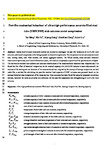Post-fire mechanical behaviour of ultra-high-performance concrete-filled steel tube (UHPCFST) stub columns under compression
| dc.contributor.author | Wang, T | |
| dc.contributor.author | Yu, M | |
| dc.contributor.author | Zhang, X | |
| dc.contributor.author | Cheng, S | |
| dc.contributor.author | Liu, S | |
| dc.date.accessioned | 2023-02-13T14:12:58Z | |
| dc.date.available | 2023-02-13T14:12:58Z | |
| dc.date.issued | 2022-09 | |
| dc.identifier.issn | 0143-974X | |
| dc.identifier.issn | 1873-5983 | |
| dc.identifier.other | 107384 | |
| dc.identifier.uri | http://hdl.handle.net/10026.1/20300 | |
| dc.description.abstract |
Twenty-four full-scale tests were carried out in order to investigate the post-fire behaviour of UHPCFST stub columns under axial compression after being exposed to elevated temperatures. The test parameters include cross-sectional size, heating mode, steel fibre content, and coarse aggregate content. The failure modes, cross-sectional historical maximum temperatures, axial load-deformation curves, and residual compressive capacities of the specimens are analysed. The test results revealed non-uniform and nonlinear distributions of the cross-sectional historical-max temperatures. It is found that the effect of historical temperature on the residual capacity of a UHPCFST column is more obvious with the increase of the heating rate and decrease of the cross-sectional size. Inspired by the concept of average temperature method under fire, a method for calculating the post-fire residual load capacity of CFST columns was proposed based on the average historical-max temperature of the cross-section. High accuracy has been found for using the proposed calculation method, therefore the work could serve as a reference for the post-fire assessment and strengthening of UHPCFST stub columns. | |
| dc.format.extent | 107384-107384 | |
| dc.language | en | |
| dc.language.iso | en | |
| dc.publisher | Elsevier BV | |
| dc.subject | Ultra-high-performance concrete-filled steel | |
| dc.subject | tube | |
| dc.subject | Post fire | |
| dc.subject | Average historical-max temperature | |
| dc.subject | Bearing capacity | |
| dc.title | Post-fire mechanical behaviour of ultra-high-performance concrete-filled steel tube (UHPCFST) stub columns under compression | |
| dc.type | journal-article | |
| dc.type | Article | |
| plymouth.author-url | https://www.webofscience.com/api/gateway?GWVersion=2&SrcApp=PARTNER_APP&SrcAuth=LinksAMR&KeyUT=WOS:000819226100002&DestLinkType=FullRecord&DestApp=ALL_WOS&UsrCustomerID=11bb513d99f797142bcfeffcc58ea008 | |
| plymouth.volume | 196 | |
| plymouth.publication-status | Published | |
| plymouth.journal | Journal of Constructional Steel Research | |
| dc.identifier.doi | 10.1016/j.jcsr.2022.107384 | |
| plymouth.organisational-group | /Plymouth | |
| plymouth.organisational-group | /Plymouth/Faculty of Science and Engineering | |
| plymouth.organisational-group | /Plymouth/Faculty of Science and Engineering/School of Engineering, Computing and Mathematics | |
| plymouth.organisational-group | /Plymouth/REF 2021 Researchers by UoA | |
| plymouth.organisational-group | /Plymouth/REF 2021 Researchers by UoA/UoA12 Engineering | |
| plymouth.organisational-group | /Plymouth/Users by role | |
| plymouth.organisational-group | /Plymouth/Users by role/Academics | |
| dcterms.dateAccepted | 2022-06-10 | |
| dc.rights.embargodate | 2023-6-20 | |
| dc.identifier.eissn | 1873-5983 | |
| dc.rights.embargoperiod | Not known | |
| rioxxterms.versionofrecord | 10.1016/j.jcsr.2022.107384 | |
| rioxxterms.licenseref.uri | http://www.rioxx.net/licenses/all-rights-reserved | |
| rioxxterms.type | Journal Article/Review |


